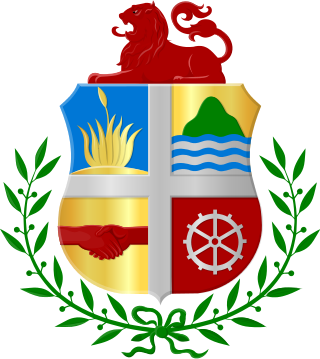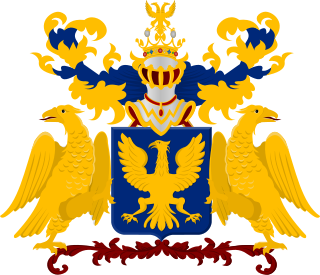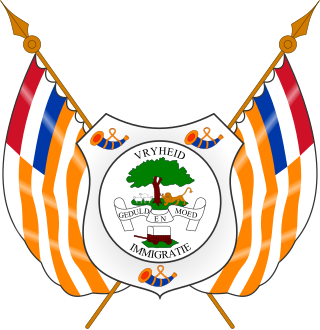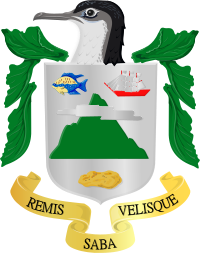
The Coat of arms of Aruba has been officially in use since November 15, 1955, as the recognized national symbol of Aruba.

The coat of arms of Amsterdam is the official coat of arms symbol of the city of Amsterdam. It consists of a red shield and a black pale with three silver Saint Andrew's Crosses, the Imperial Crown of Austria, two golden lions, and the motto of Amsterdam. Several heraldic elements have their basis in the history of Amsterdam. The crosses and the crown can be found as decorations on different locations in the city.

The Netherlands Antilles was an autonomous Caribbean country within the Kingdom of the Netherlands. It was dissolved on 10 October 2010.

Van Heemstra is a family that belongs to the Dutch nobility.

The Crown of the Netherlands is of relatively modern origin. In 1813 the new "Sovereign Ruler" of the Netherlands, Prince Willem of Orange, son and heir of the exiled stadtholder Willem V of Orange, was sworn in as Dutch monarch in Amsterdam. There was no crown present at the ceremony.

The Kingdom of the Netherlands, commonly known simply as the Netherlands, is a sovereign state consisting of a collection of constituent territories united under the monarch of the Netherlands, who functions as head of state. The realm is not a federation; it is a unitary monarchy with its largest subdivision, the eponymous Netherlands, predominantly located in Northwestern Europe and with several smaller island territories located in the Caribbean.

The study of Dutch heraldry focuses on the use of coats of arms and other insignia in the country of the Netherlands. Dutch heraldry is characterised by its simple and rather sober style, and in this sense, is closer to its medieval origins than the elaborate styles which developed in other heraldic traditions.

The coat of arms of the Orange Free State was the official heraldic symbol of the Orange Free State as a republic from 1857 to 1902, and later, from 1937 to 1994, as a province of South Africa. It is now obsolete.

The coat of arms of Rotterdam is the official symbol of the city of Rotterdam. It consists of a shield and has a green band of the original weapon of Weena, bisected by a white band symbolizes the Rotte, two golden lions, and four lions, two black and two red on a gold field, and the motto of Rotterdam.

The coat of arms of Sint Eustatius consists of a shield and the motto. It was established on 9 November 2004 by the Island council of Sint Eustatius, when it was still part of the Netherlands Antilles. It remained the coat of arms of Sint Eustatius after the dissolution of the Netherlands Antilles and the subsequent change of Sint Eustatius's constitutional status into a special municipality of the Netherlands in 2010.

The Emblem of Curaçao is a yet to be adopted national symbol of Curaçao. The design will be based on a concept by Andresetti Monart featuring the Queen Emma Bridge, a cactus, a hummingbird and a traditional fishing boat, which was chosen through a design competition held in 2022. The emblem is set to replace the coat of arms of Curaçao, which has been in use since 24 July 1964.

The coat of arms of Bonaire was established in 1986 by the island council, when Bonaire was still part of the Netherlands Antilles. It remained the coat of arms of Bonaire after the dissolution of the Netherlands Antilles and the subsequent change of Bonaire's constitutional status into a special municipality of the Netherlands in 2010.

The coat of arms of The Hague is the official symbol of the city of The Hague.

The coat of arms of Hoorn is a coat of arms that has been in use since the Middle Ages. Although over time it underwent some changes, there has been no change to the coat of arms since it was acknowledged in use by the High Council of Nobility in 1816. At present, in the original form, it is the coat of arms of the municipality of Hoorn. The current municipality was formed in 1979 by merging the city of Hoorn with the villages Zwaag and Westerblokker; it was decided to use the old coat of arms as coat of arms of the new municipality.

The coat of arms of Zaanstad has been formally acknowledged since 27 February 1974. The coat of arms was previously that of the jurisdictional area of Westsane en Crommenie, which now form the municipality of Zaanstad. These two areas were on the same areas as the municipalities who fused in 1974 to become the municipality of Zaanstad. The municipality of Assendelft alone used a coat of arms who didn't look like those of the other municipalities. The other municipalities and places used a coat of arms with four lions in it.

The flag of Scheveningen is in azure with three right swimming herrings of silver, each herring with a three-leaved yellow crown, floating above the head. The origin of the coat of arms is a matter of debate because Scheveningen is not, and never has been, an autonomous municipality. Since the village was founded in 1284, Scheveningen has always been a part of the municipality of The Hague.

The coat of arms of Groningen is an official symbol of the province. It was designed when the region was united in 1595 and formally approved in 1947 by Queen Wilhelmina. The coat of arms consists of two lions supporting a crowned shield which is decorated with the shields of the city of Groningen and of the Ommelanden.

The coat of arms of Enkhuizen has been the coat of arms ever since Enkhuizen received borough rights in 1355. The coat of arms was acknowledged in 1816 by the High Council of Nobility, the coat of arms has not been changed ever since.
This page shows the coats of arms, heraldic achievements, and heraldic flags of the House of Nassau.



















